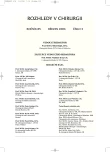Mucus Production Consequences in Cystoplasties and Continent Urinary Diversions in Children – Long Term Experiences
Následky produkce hlenu u cystoplastik a náhrad močového měchýře u dětí – dlouhodobé zkušenosti
Úvod:
Rekonstrukční operace s použitím části střeva nebo žaludku jsou neoddělitelnou součástí chirurgické péče o děti s těžkým postižením dolních močových cest. Jednou z nevýhod těchto operací je přetrvávající sekrece sliznice gastrointestinálního traktu. Cílem studie je zhodnocení komplikací spojených s nadměrnou produkcí hlenu a současnou nedostatečnou spoluprací pacientů s různými typy cystoplastik a náhrad močového měchýře.
Soubor pacientů, metodika:
V letech 1991–2005 bylo operováno 45 dětí ve věku 2–18 let, u kterých byla konstruována ileocékální neovezika (13), ileocystoplastika (25), sigmoideocystoplastika (2), gastroileocystoplastika (1) a gastrocystoplastika (4) s kontinentním stomatem ileálním (5) a apendikálním (24). U 16 dětí byla provedena pouze augmentace močového měchýře. Ve studii byly zhodnoceny výsledky operace se zvláštním zřetelem ke komplikacím v podobě tvorby hlenu, konkrementů a ruptury močového měchýře. Sledovaná data byla získána ze zdravotní dokumentace a rozeslaných dotazníků.
Výsledky:
Kontinence je dosaženo u 97 % pacientů s kontinentním stomatem a u 81 % pacientů s ponechanou močovou trubicí. Nadměrná tvorba hlenu byla pozorována u 13 (29 %) pacientů, urolitiáza a ruptura neoveziky u 2 (4 %) dětí. Hlenem naplněný močový měchýř nebo jeho náhrada si vyžádala urgentní proplach u 3 (7 %) pacientů. Pravidelný proplach měchýře v současné době doma provádí 26 (58 %) dětí.
Závěr:
Kontinentní derivace moči s použitím střevního nebo gastrického segmentu zvyšuje kvalitu života u těžce postižených pacientů, přesto je však řešením nedokonalým, provázeným metabolickými i mechanickými komplikacemi. Těm nelze zabránit pouze vhodnou operační technikou, nezbytná je i dostatečná spolupráce pacienta a jeho rodičů.
Klíčová slova:
kontinentní derivace – cystoplastika – intermitentní katetrizace – produkce hlenu – komplikace
Authors:
P. Zerhau; M. Husár
Authors‘ workplace:
Klinika dětské chirurgie, ortopedie a traumatologie FN Brno, přednosta prof. MUDr. P. Gál, PhD.
Published in:
Rozhl. Chir., 2006, roč. 85, č. 3, s. 148-150.
Category:
Monothematic special - Original
Overview
Introduction:
Following transposition into the urinary tract, intestinal segments continue to produce mucus and problems related to excessive production do not to diminish with time. The aim of the study is to assess complications connected with excessive mucous production in unsatisfactory cooperative patients with various types of cystoplasties and urinary bladder replacements.
Patients and methods:
45 children aged 2–18 years underwent surgery between 1991 and 2005 in our department. Ileocecal urinary reservoir (13), ileocystoplasty (25), sigmoideocystoplasty (2), gastroileocystoplasty (1) and gastrocystoplasty (4) with continent appendicovesicostomy (25) and ileovesicostomy (5) were created. Surgical results with a particular attention to the complications of mucous retention, calculus formation and ruptures of the neobladder were assessed on the basis of data from questionnaires mailed to relevant patients and from their medical documents.
Results:
Full continence was achieved in 97% patients with catheterizable stoma and 81% children with patent urethra. Excessive mucous production occured in 13 (29%) children, reservoir calculi and neobladder rupture in 2 (4%) patients. In this time, 26 (58%) children practise regular irrigation.
Conclusion:
Although continent urinary diversion using intestinal or gastric segments may improve the quality of life in severely affected patients, it remains an imperfect solution requiring significant cooperation from patients. Many problems may be prevented by the use of suitable surgical techniques, the mucus production and lithiasis by regular catheterization and lavages of the urinary bladder only. The recommended procedures are, however, sometimes neglected even by properly instructed patients or their parents.
Key words:
continent urinary diversion – cystoplasty – intermitent catheterization – mucus production – complications
Labels
Surgery Orthopaedics Trauma surgeryArticle was published in
Perspectives in Surgery

2006 Issue 3
- Metamizole vs. Tramadol in Postoperative Analgesia
- Metamizole at a Glance and in Practice – Effective Non-Opioid Analgesic for All Ages
- Metamizole in the Treatment of Acute Postoperative Pain
Most read in this issue
- Surgical Management of Major Scrotal Hernias
- Postoperative Adhesions, the Everlasting Topical Subject
- Rare Compartment Syndromes of the Peripheral Nerves of the Forearm and Distal Leg
- Postoperative Re-stenosis of the Carotid – A Case for Reoperation or Endovascular Management?
